International Business Strategies: A Comparative Analysis of Companies
VerifiedAdded on 2022/11/13
|7
|1798
|252
Report
AI Summary
This report provides a comparative analysis of the international business strategies employed by five multinational companies: Mountain Dew, Orbit, Lays, Campbell's Soup, and Domino's Pizza. The analysis explores how each company leverages different strategies to achieve competitive advantage in the global market. Mountain Dew utilizes differentiation, focusing on product innovation and addressing consumer health concerns. Orbit employs a low-cost strategy to increase sales volume, while Lays combines low-cost and differentiation strategies to target a broad customer base. Campbell's Soup uses a focused cost leadership strategy, targeting a specific market segment with competitive pricing, and Domino's Pizza employs differentiated pricing and service strategies, emphasizing product attributes and convenient delivery. The report also references relevant academic literature to support the analysis of each company's strategic approach.

International business
I
I
Paraphrase This Document
Need a fresh take? Get an instant paraphrase of this document with our AI Paraphraser
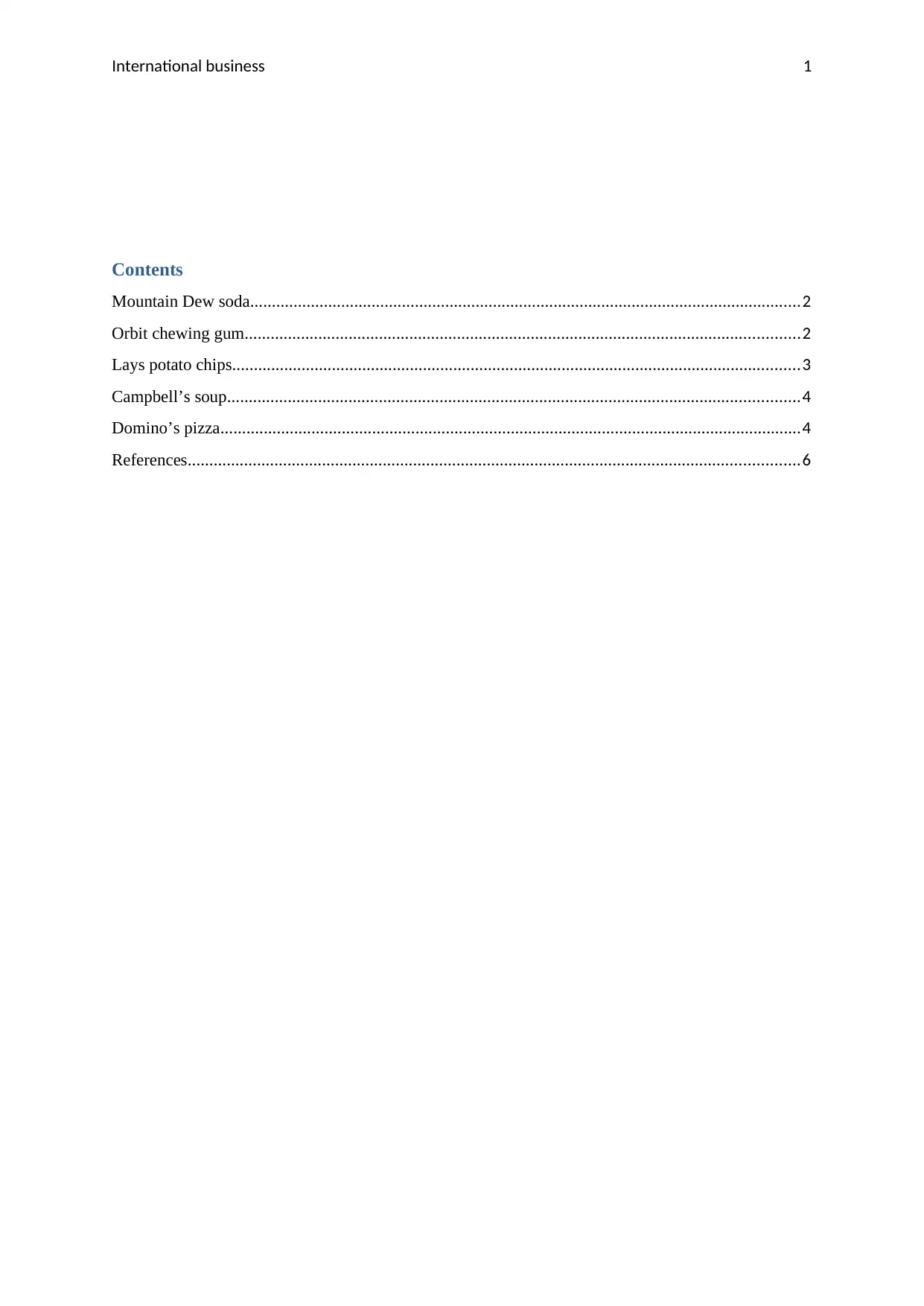
International business 1
Contents
Mountain Dew soda...............................................................................................................................2
Orbit chewing gum................................................................................................................................2
Lays potato chips...................................................................................................................................3
Campbell’s soup....................................................................................................................................4
Domino’s pizza......................................................................................................................................4
References.............................................................................................................................................6
Contents
Mountain Dew soda...............................................................................................................................2
Orbit chewing gum................................................................................................................................2
Lays potato chips...................................................................................................................................3
Campbell’s soup....................................................................................................................................4
Domino’s pizza......................................................................................................................................4
References.............................................................................................................................................6
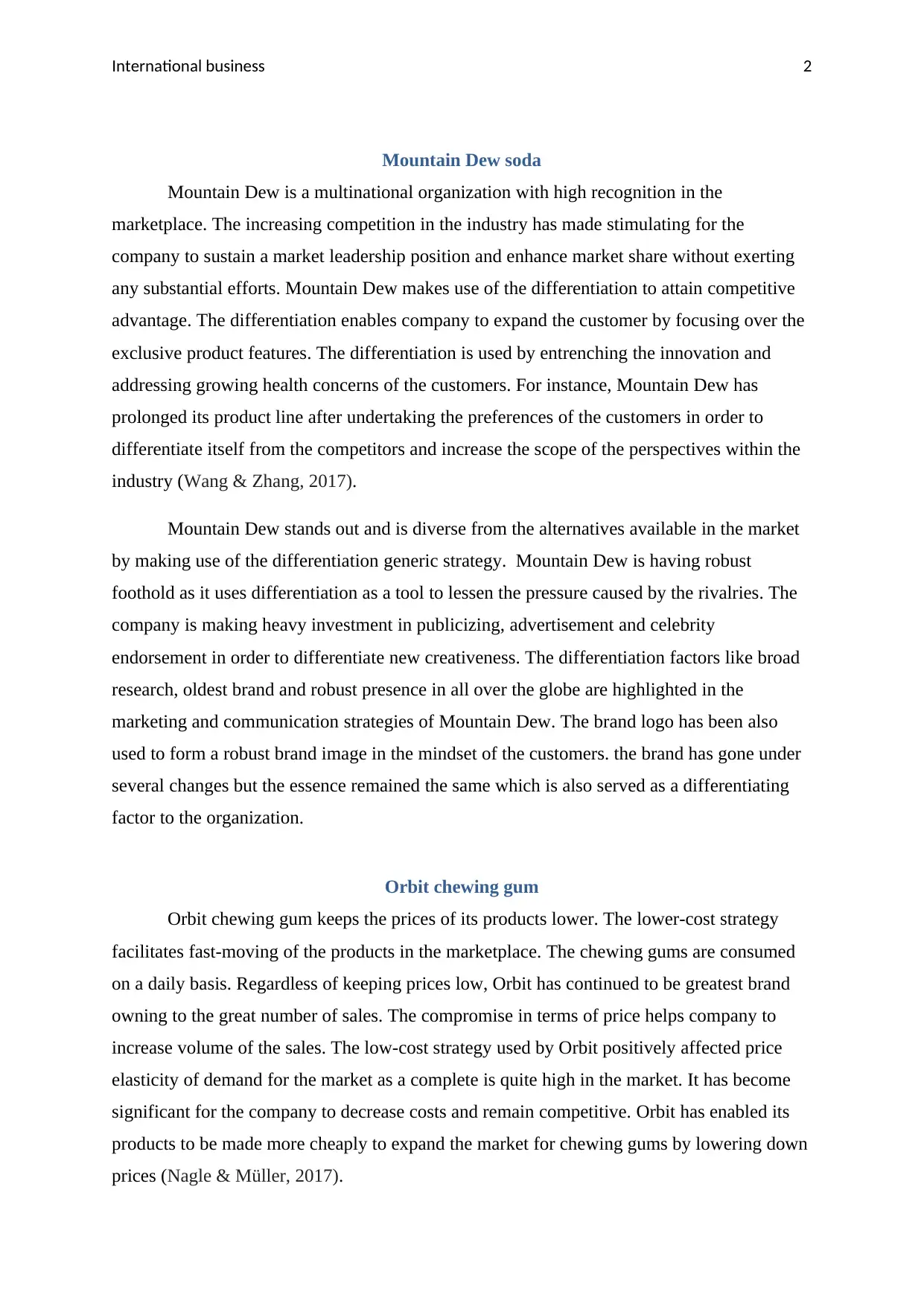
International business 2
Mountain Dew soda
Mountain Dew is a multinational organization with high recognition in the
marketplace. The increasing competition in the industry has made stimulating for the
company to sustain a market leadership position and enhance market share without exerting
any substantial efforts. Mountain Dew makes use of the differentiation to attain competitive
advantage. The differentiation enables company to expand the customer by focusing over the
exclusive product features. The differentiation is used by entrenching the innovation and
addressing growing health concerns of the customers. For instance, Mountain Dew has
prolonged its product line after undertaking the preferences of the customers in order to
differentiate itself from the competitors and increase the scope of the perspectives within the
industry (Wang & Zhang, 2017).
Mountain Dew stands out and is diverse from the alternatives available in the market
by making use of the differentiation generic strategy. Mountain Dew is having robust
foothold as it uses differentiation as a tool to lessen the pressure caused by the rivalries. The
company is making heavy investment in publicizing, advertisement and celebrity
endorsement in order to differentiate new creativeness. The differentiation factors like broad
research, oldest brand and robust presence in all over the globe are highlighted in the
marketing and communication strategies of Mountain Dew. The brand logo has been also
used to form a robust brand image in the mindset of the customers. the brand has gone under
several changes but the essence remained the same which is also served as a differentiating
factor to the organization.
Orbit chewing gum
Orbit chewing gum keeps the prices of its products lower. The lower-cost strategy
facilitates fast-moving of the products in the marketplace. The chewing gums are consumed
on a daily basis. Regardless of keeping prices low, Orbit has continued to be greatest brand
owning to the great number of sales. The compromise in terms of price helps company to
increase volume of the sales. The low-cost strategy used by Orbit positively affected price
elasticity of demand for the market as a complete is quite high in the market. It has become
significant for the company to decrease costs and remain competitive. Orbit has enabled its
products to be made more cheaply to expand the market for chewing gums by lowering down
prices (Nagle & Müller, 2017).
Mountain Dew soda
Mountain Dew is a multinational organization with high recognition in the
marketplace. The increasing competition in the industry has made stimulating for the
company to sustain a market leadership position and enhance market share without exerting
any substantial efforts. Mountain Dew makes use of the differentiation to attain competitive
advantage. The differentiation enables company to expand the customer by focusing over the
exclusive product features. The differentiation is used by entrenching the innovation and
addressing growing health concerns of the customers. For instance, Mountain Dew has
prolonged its product line after undertaking the preferences of the customers in order to
differentiate itself from the competitors and increase the scope of the perspectives within the
industry (Wang & Zhang, 2017).
Mountain Dew stands out and is diverse from the alternatives available in the market
by making use of the differentiation generic strategy. Mountain Dew is having robust
foothold as it uses differentiation as a tool to lessen the pressure caused by the rivalries. The
company is making heavy investment in publicizing, advertisement and celebrity
endorsement in order to differentiate new creativeness. The differentiation factors like broad
research, oldest brand and robust presence in all over the globe are highlighted in the
marketing and communication strategies of Mountain Dew. The brand logo has been also
used to form a robust brand image in the mindset of the customers. the brand has gone under
several changes but the essence remained the same which is also served as a differentiating
factor to the organization.
Orbit chewing gum
Orbit chewing gum keeps the prices of its products lower. The lower-cost strategy
facilitates fast-moving of the products in the marketplace. The chewing gums are consumed
on a daily basis. Regardless of keeping prices low, Orbit has continued to be greatest brand
owning to the great number of sales. The compromise in terms of price helps company to
increase volume of the sales. The low-cost strategy used by Orbit positively affected price
elasticity of demand for the market as a complete is quite high in the market. It has become
significant for the company to decrease costs and remain competitive. Orbit has enabled its
products to be made more cheaply to expand the market for chewing gums by lowering down
prices (Nagle & Müller, 2017).
⊘ This is a preview!⊘
Do you want full access?
Subscribe today to unlock all pages.

Trusted by 1+ million students worldwide
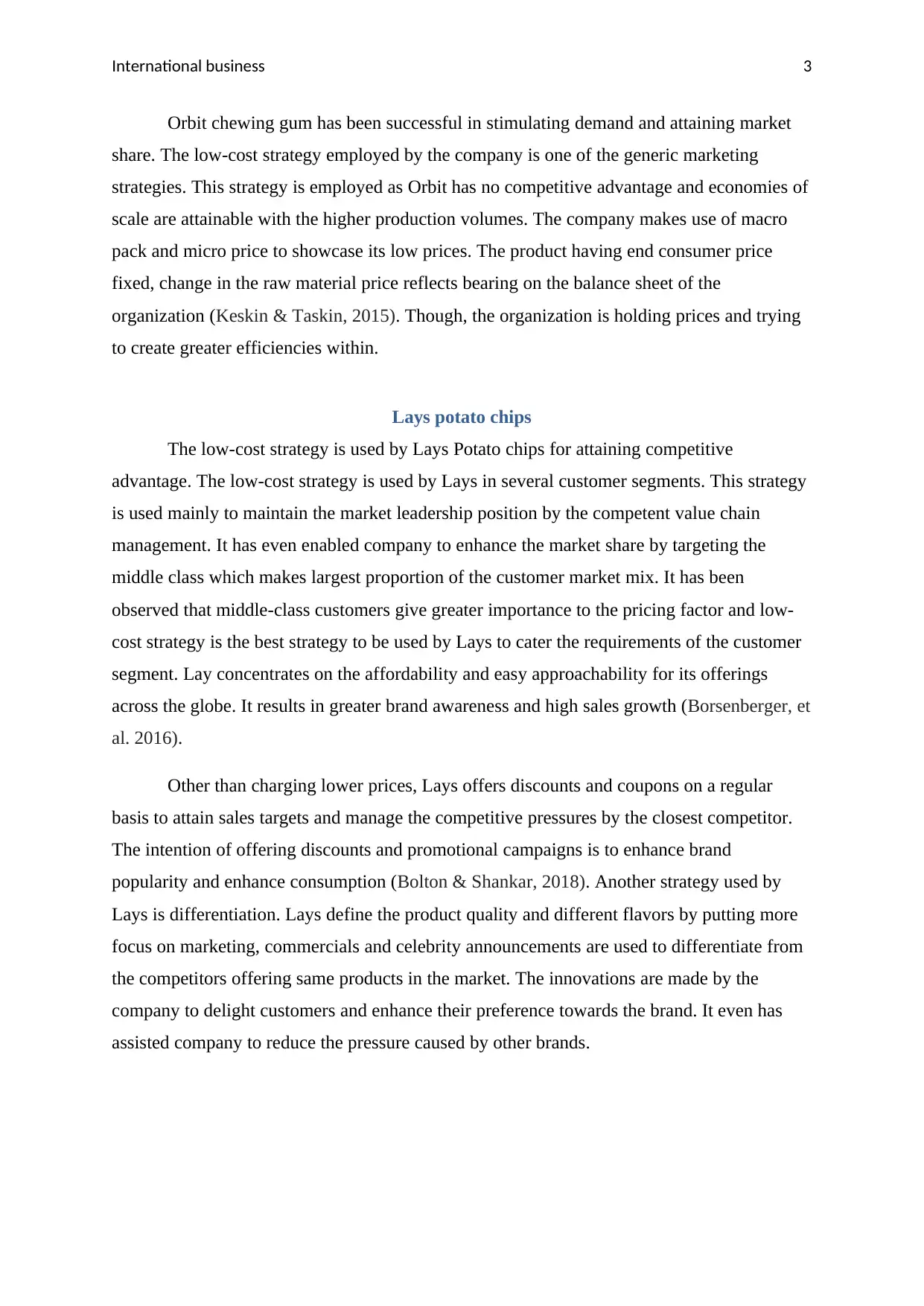
International business 3
Orbit chewing gum has been successful in stimulating demand and attaining market
share. The low-cost strategy employed by the company is one of the generic marketing
strategies. This strategy is employed as Orbit has no competitive advantage and economies of
scale are attainable with the higher production volumes. The company makes use of macro
pack and micro price to showcase its low prices. The product having end consumer price
fixed, change in the raw material price reflects bearing on the balance sheet of the
organization (Keskin & Taskin, 2015). Though, the organization is holding prices and trying
to create greater efficiencies within.
Lays potato chips
The low-cost strategy is used by Lays Potato chips for attaining competitive
advantage. The low-cost strategy is used by Lays in several customer segments. This strategy
is used mainly to maintain the market leadership position by the competent value chain
management. It has even enabled company to enhance the market share by targeting the
middle class which makes largest proportion of the customer market mix. It has been
observed that middle-class customers give greater importance to the pricing factor and low-
cost strategy is the best strategy to be used by Lays to cater the requirements of the customer
segment. Lay concentrates on the affordability and easy approachability for its offerings
across the globe. It results in greater brand awareness and high sales growth (Borsenberger, et
al. 2016).
Other than charging lower prices, Lays offers discounts and coupons on a regular
basis to attain sales targets and manage the competitive pressures by the closest competitor.
The intention of offering discounts and promotional campaigns is to enhance brand
popularity and enhance consumption (Bolton & Shankar, 2018). Another strategy used by
Lays is differentiation. Lays define the product quality and different flavors by putting more
focus on marketing, commercials and celebrity announcements are used to differentiate from
the competitors offering same products in the market. The innovations are made by the
company to delight customers and enhance their preference towards the brand. It even has
assisted company to reduce the pressure caused by other brands.
Orbit chewing gum has been successful in stimulating demand and attaining market
share. The low-cost strategy employed by the company is one of the generic marketing
strategies. This strategy is employed as Orbit has no competitive advantage and economies of
scale are attainable with the higher production volumes. The company makes use of macro
pack and micro price to showcase its low prices. The product having end consumer price
fixed, change in the raw material price reflects bearing on the balance sheet of the
organization (Keskin & Taskin, 2015). Though, the organization is holding prices and trying
to create greater efficiencies within.
Lays potato chips
The low-cost strategy is used by Lays Potato chips for attaining competitive
advantage. The low-cost strategy is used by Lays in several customer segments. This strategy
is used mainly to maintain the market leadership position by the competent value chain
management. It has even enabled company to enhance the market share by targeting the
middle class which makes largest proportion of the customer market mix. It has been
observed that middle-class customers give greater importance to the pricing factor and low-
cost strategy is the best strategy to be used by Lays to cater the requirements of the customer
segment. Lay concentrates on the affordability and easy approachability for its offerings
across the globe. It results in greater brand awareness and high sales growth (Borsenberger, et
al. 2016).
Other than charging lower prices, Lays offers discounts and coupons on a regular
basis to attain sales targets and manage the competitive pressures by the closest competitor.
The intention of offering discounts and promotional campaigns is to enhance brand
popularity and enhance consumption (Bolton & Shankar, 2018). Another strategy used by
Lays is differentiation. Lays define the product quality and different flavors by putting more
focus on marketing, commercials and celebrity announcements are used to differentiate from
the competitors offering same products in the market. The innovations are made by the
company to delight customers and enhance their preference towards the brand. It even has
assisted company to reduce the pressure caused by other brands.
Paraphrase This Document
Need a fresh take? Get an instant paraphrase of this document with our AI Paraphraser
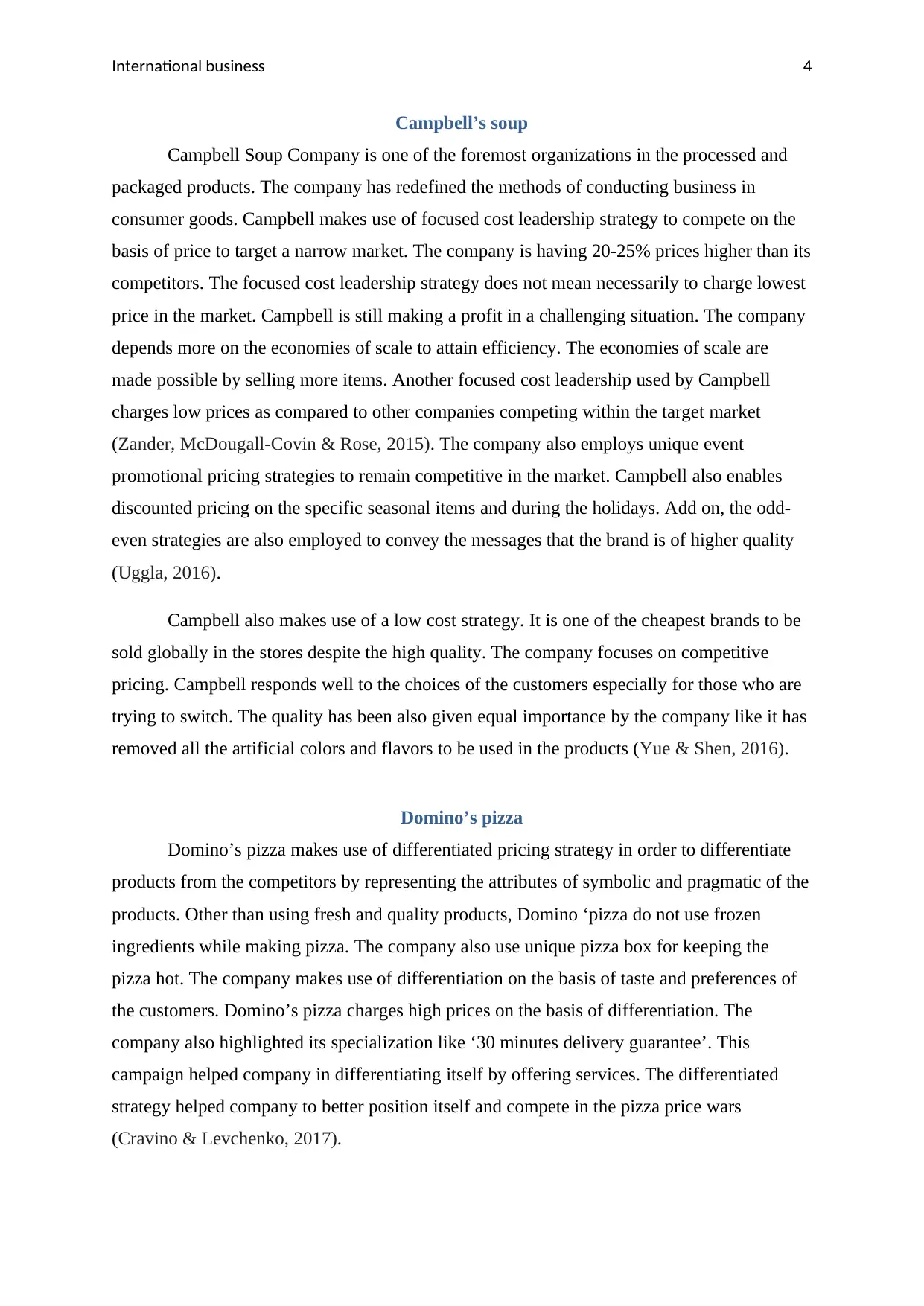
International business 4
Campbell’s soup
Campbell Soup Company is one of the foremost organizations in the processed and
packaged products. The company has redefined the methods of conducting business in
consumer goods. Campbell makes use of focused cost leadership strategy to compete on the
basis of price to target a narrow market. The company is having 20-25% prices higher than its
competitors. The focused cost leadership strategy does not mean necessarily to charge lowest
price in the market. Campbell is still making a profit in a challenging situation. The company
depends more on the economies of scale to attain efficiency. The economies of scale are
made possible by selling more items. Another focused cost leadership used by Campbell
charges low prices as compared to other companies competing within the target market
(Zander, McDougall-Covin & Rose, 2015). The company also employs unique event
promotional pricing strategies to remain competitive in the market. Campbell also enables
discounted pricing on the specific seasonal items and during the holidays. Add on, the odd-
even strategies are also employed to convey the messages that the brand is of higher quality
(Uggla, 2016).
Campbell also makes use of a low cost strategy. It is one of the cheapest brands to be
sold globally in the stores despite the high quality. The company focuses on competitive
pricing. Campbell responds well to the choices of the customers especially for those who are
trying to switch. The quality has been also given equal importance by the company like it has
removed all the artificial colors and flavors to be used in the products (Yue & Shen, 2016).
Domino’s pizza
Domino’s pizza makes use of differentiated pricing strategy in order to differentiate
products from the competitors by representing the attributes of symbolic and pragmatic of the
products. Other than using fresh and quality products, Domino ‘pizza do not use frozen
ingredients while making pizza. The company also use unique pizza box for keeping the
pizza hot. The company makes use of differentiation on the basis of taste and preferences of
the customers. Domino’s pizza charges high prices on the basis of differentiation. The
company also highlighted its specialization like ‘30 minutes delivery guarantee’. This
campaign helped company in differentiating itself by offering services. The differentiated
strategy helped company to better position itself and compete in the pizza price wars
(Cravino & Levchenko, 2017).
Campbell’s soup
Campbell Soup Company is one of the foremost organizations in the processed and
packaged products. The company has redefined the methods of conducting business in
consumer goods. Campbell makes use of focused cost leadership strategy to compete on the
basis of price to target a narrow market. The company is having 20-25% prices higher than its
competitors. The focused cost leadership strategy does not mean necessarily to charge lowest
price in the market. Campbell is still making a profit in a challenging situation. The company
depends more on the economies of scale to attain efficiency. The economies of scale are
made possible by selling more items. Another focused cost leadership used by Campbell
charges low prices as compared to other companies competing within the target market
(Zander, McDougall-Covin & Rose, 2015). The company also employs unique event
promotional pricing strategies to remain competitive in the market. Campbell also enables
discounted pricing on the specific seasonal items and during the holidays. Add on, the odd-
even strategies are also employed to convey the messages that the brand is of higher quality
(Uggla, 2016).
Campbell also makes use of a low cost strategy. It is one of the cheapest brands to be
sold globally in the stores despite the high quality. The company focuses on competitive
pricing. Campbell responds well to the choices of the customers especially for those who are
trying to switch. The quality has been also given equal importance by the company like it has
removed all the artificial colors and flavors to be used in the products (Yue & Shen, 2016).
Domino’s pizza
Domino’s pizza makes use of differentiated pricing strategy in order to differentiate
products from the competitors by representing the attributes of symbolic and pragmatic of the
products. Other than using fresh and quality products, Domino ‘pizza do not use frozen
ingredients while making pizza. The company also use unique pizza box for keeping the
pizza hot. The company makes use of differentiation on the basis of taste and preferences of
the customers. Domino’s pizza charges high prices on the basis of differentiation. The
company also highlighted its specialization like ‘30 minutes delivery guarantee’. This
campaign helped company in differentiating itself by offering services. The differentiated
strategy helped company to better position itself and compete in the pizza price wars
(Cravino & Levchenko, 2017).
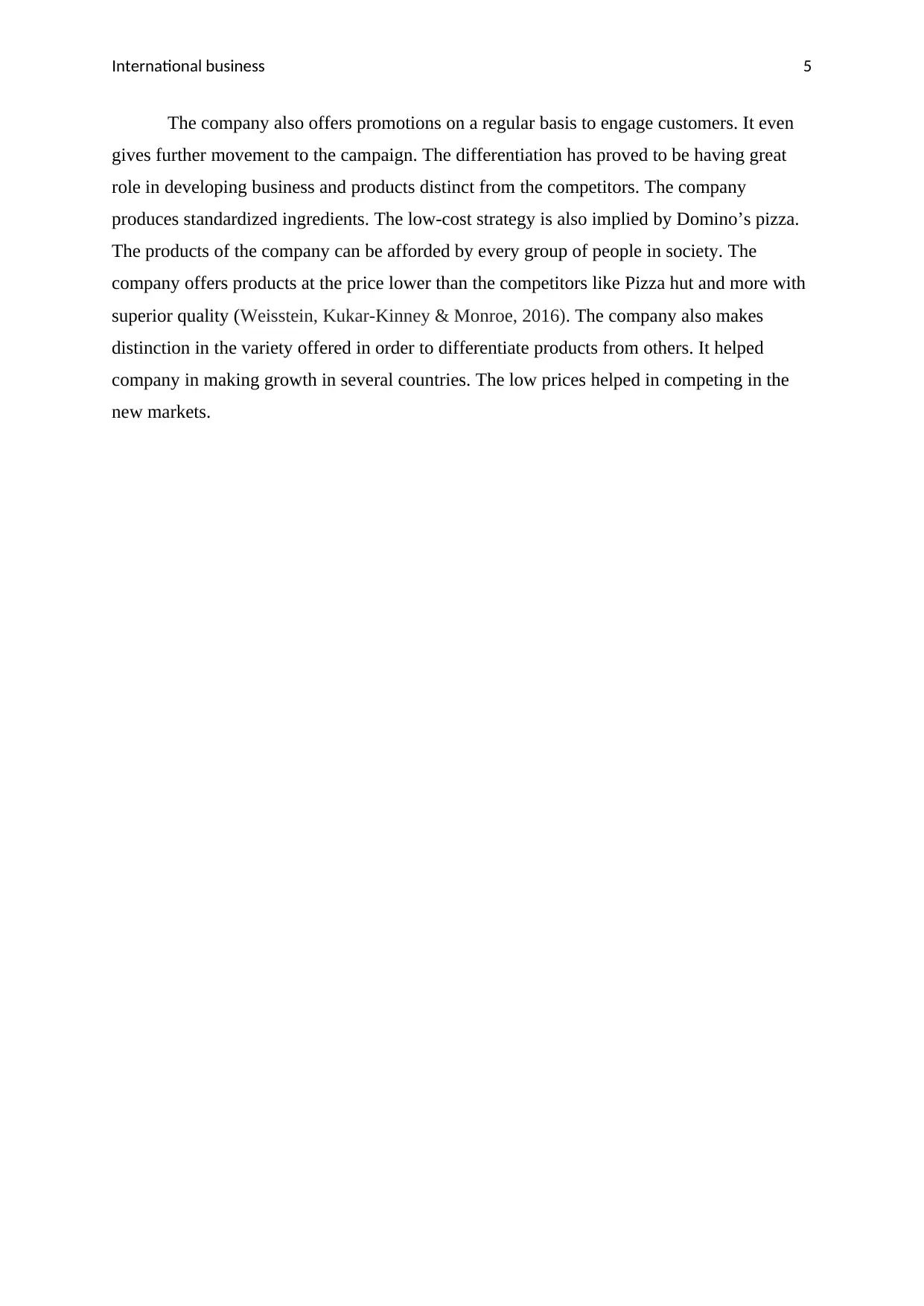
International business 5
The company also offers promotions on a regular basis to engage customers. It even
gives further movement to the campaign. The differentiation has proved to be having great
role in developing business and products distinct from the competitors. The company
produces standardized ingredients. The low-cost strategy is also implied by Domino’s pizza.
The products of the company can be afforded by every group of people in society. The
company offers products at the price lower than the competitors like Pizza hut and more with
superior quality (Weisstein, Kukar-Kinney & Monroe, 2016). The company also makes
distinction in the variety offered in order to differentiate products from others. It helped
company in making growth in several countries. The low prices helped in competing in the
new markets.
The company also offers promotions on a regular basis to engage customers. It even
gives further movement to the campaign. The differentiation has proved to be having great
role in developing business and products distinct from the competitors. The company
produces standardized ingredients. The low-cost strategy is also implied by Domino’s pizza.
The products of the company can be afforded by every group of people in society. The
company offers products at the price lower than the competitors like Pizza hut and more with
superior quality (Weisstein, Kukar-Kinney & Monroe, 2016). The company also makes
distinction in the variety offered in order to differentiate products from others. It helped
company in making growth in several countries. The low prices helped in competing in the
new markets.
⊘ This is a preview!⊘
Do you want full access?
Subscribe today to unlock all pages.

Trusted by 1+ million students worldwide
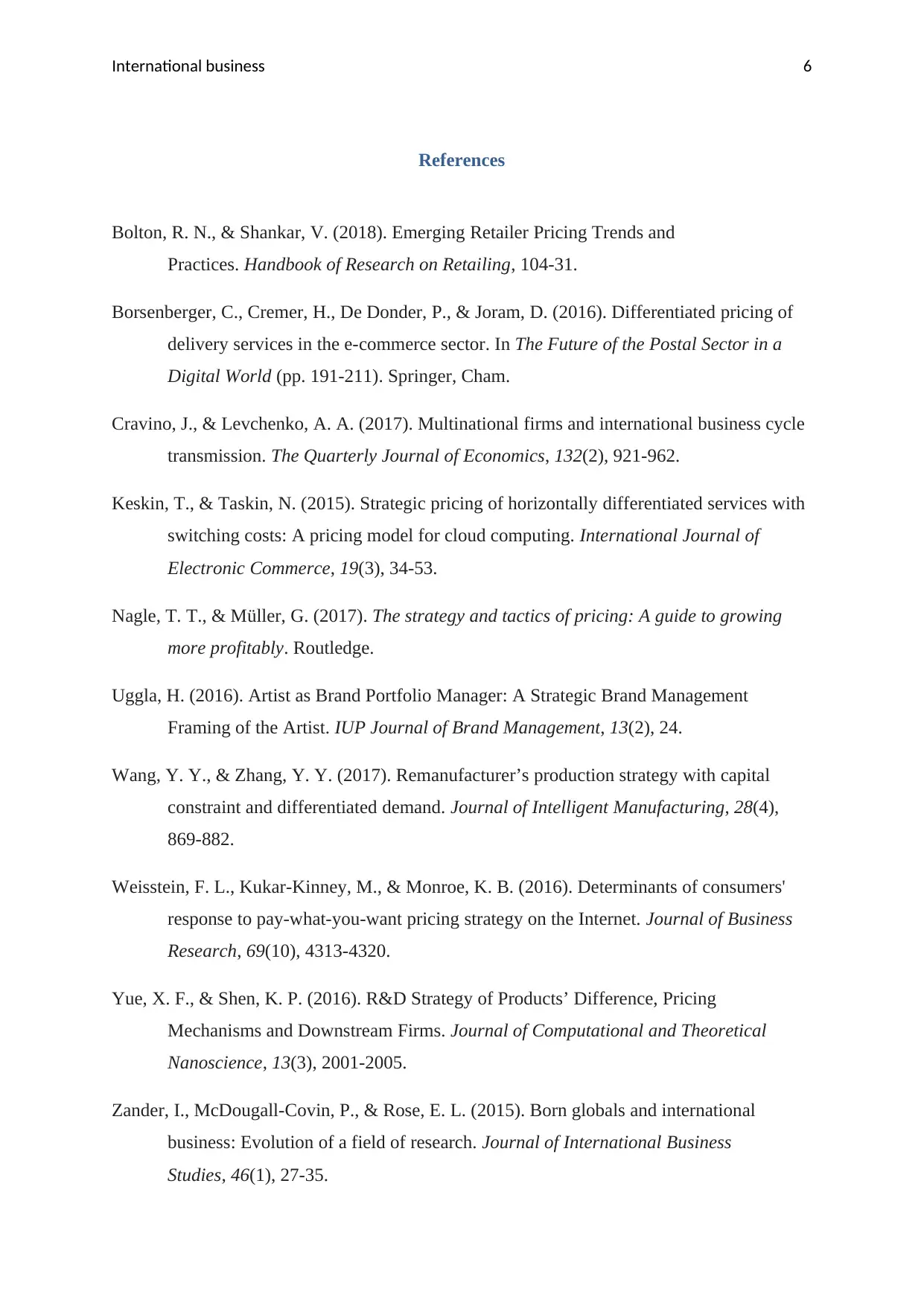
International business 6
References
Bolton, R. N., & Shankar, V. (2018). Emerging Retailer Pricing Trends and
Practices. Handbook of Research on Retailing, 104-31.
Borsenberger, C., Cremer, H., De Donder, P., & Joram, D. (2016). Differentiated pricing of
delivery services in the e-commerce sector. In The Future of the Postal Sector in a
Digital World (pp. 191-211). Springer, Cham.
Cravino, J., & Levchenko, A. A. (2017). Multinational firms and international business cycle
transmission. The Quarterly Journal of Economics, 132(2), 921-962.
Keskin, T., & Taskin, N. (2015). Strategic pricing of horizontally differentiated services with
switching costs: A pricing model for cloud computing. International Journal of
Electronic Commerce, 19(3), 34-53.
Nagle, T. T., & Müller, G. (2017). The strategy and tactics of pricing: A guide to growing
more profitably. Routledge.
Uggla, H. (2016). Artist as Brand Portfolio Manager: A Strategic Brand Management
Framing of the Artist. IUP Journal of Brand Management, 13(2), 24.
Wang, Y. Y., & Zhang, Y. Y. (2017). Remanufacturer’s production strategy with capital
constraint and differentiated demand. Journal of Intelligent Manufacturing, 28(4),
869-882.
Weisstein, F. L., Kukar-Kinney, M., & Monroe, K. B. (2016). Determinants of consumers'
response to pay-what-you-want pricing strategy on the Internet. Journal of Business
Research, 69(10), 4313-4320.
Yue, X. F., & Shen, K. P. (2016). R&D Strategy of Products’ Difference, Pricing
Mechanisms and Downstream Firms. Journal of Computational and Theoretical
Nanoscience, 13(3), 2001-2005.
Zander, I., McDougall-Covin, P., & Rose, E. L. (2015). Born globals and international
business: Evolution of a field of research. Journal of International Business
Studies, 46(1), 27-35.
References
Bolton, R. N., & Shankar, V. (2018). Emerging Retailer Pricing Trends and
Practices. Handbook of Research on Retailing, 104-31.
Borsenberger, C., Cremer, H., De Donder, P., & Joram, D. (2016). Differentiated pricing of
delivery services in the e-commerce sector. In The Future of the Postal Sector in a
Digital World (pp. 191-211). Springer, Cham.
Cravino, J., & Levchenko, A. A. (2017). Multinational firms and international business cycle
transmission. The Quarterly Journal of Economics, 132(2), 921-962.
Keskin, T., & Taskin, N. (2015). Strategic pricing of horizontally differentiated services with
switching costs: A pricing model for cloud computing. International Journal of
Electronic Commerce, 19(3), 34-53.
Nagle, T. T., & Müller, G. (2017). The strategy and tactics of pricing: A guide to growing
more profitably. Routledge.
Uggla, H. (2016). Artist as Brand Portfolio Manager: A Strategic Brand Management
Framing of the Artist. IUP Journal of Brand Management, 13(2), 24.
Wang, Y. Y., & Zhang, Y. Y. (2017). Remanufacturer’s production strategy with capital
constraint and differentiated demand. Journal of Intelligent Manufacturing, 28(4),
869-882.
Weisstein, F. L., Kukar-Kinney, M., & Monroe, K. B. (2016). Determinants of consumers'
response to pay-what-you-want pricing strategy on the Internet. Journal of Business
Research, 69(10), 4313-4320.
Yue, X. F., & Shen, K. P. (2016). R&D Strategy of Products’ Difference, Pricing
Mechanisms and Downstream Firms. Journal of Computational and Theoretical
Nanoscience, 13(3), 2001-2005.
Zander, I., McDougall-Covin, P., & Rose, E. L. (2015). Born globals and international
business: Evolution of a field of research. Journal of International Business
Studies, 46(1), 27-35.
1 out of 7
Related Documents
Your All-in-One AI-Powered Toolkit for Academic Success.
+13062052269
info@desklib.com
Available 24*7 on WhatsApp / Email
![[object Object]](/_next/static/media/star-bottom.7253800d.svg)
Unlock your academic potential
Copyright © 2020–2025 A2Z Services. All Rights Reserved. Developed and managed by ZUCOL.





